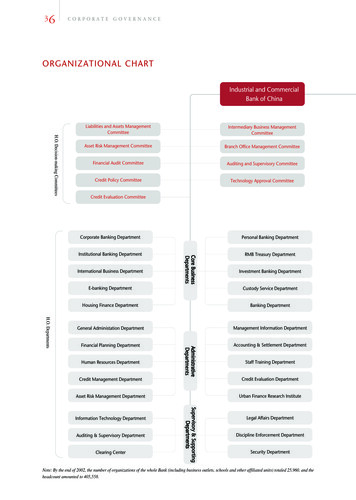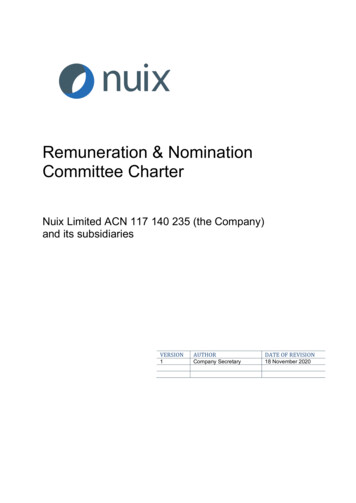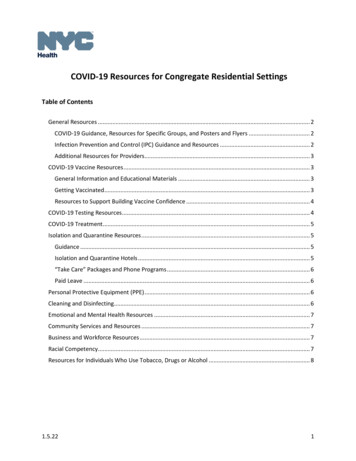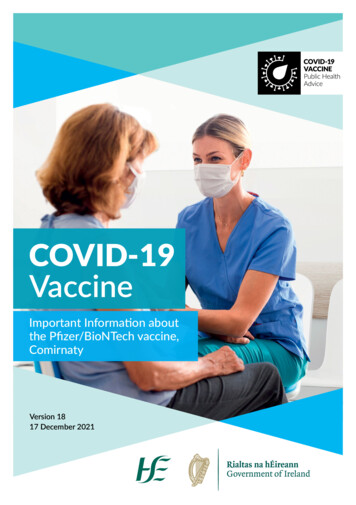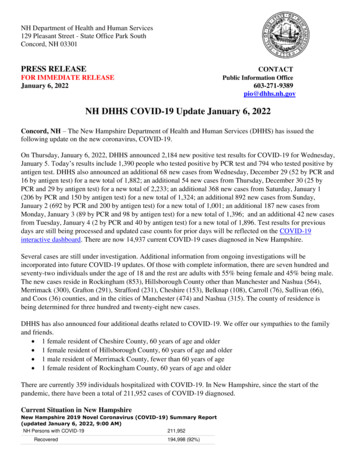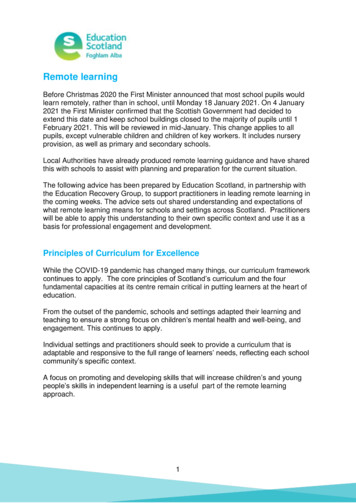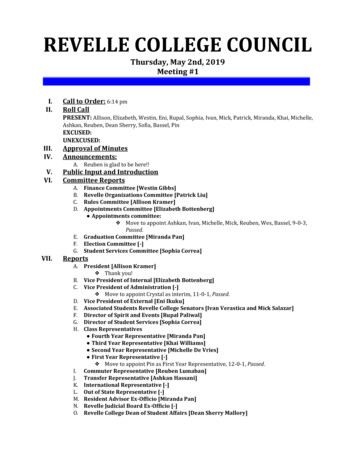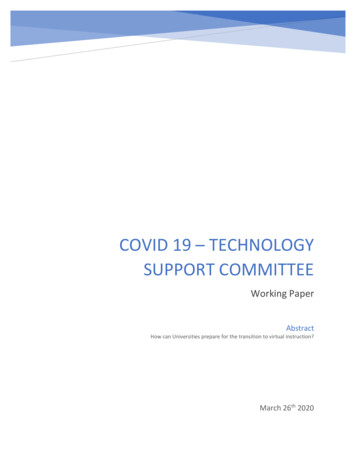
Transcription
COVID 19 – TECHNOLOGYSUPPORT COMMITTEEWorking PaperAbstractHow can Universities prepare for the transition to virtual instruction?March 26th 2020
ContentsIntroduction . 2Minimum features required for Virtual Instruction. 3Why is Video Conferencing needed? . 3Are Universities ready for this? . 4Recommendations . 5Universities with Existing Systems . 5Evaluating Alternatives & Third Party Solutions . 5Next Steps . 6Annexure A – Technology Solutions . 7Annexure B – LMS Features & Cost Estimates . 8Annexure C – Video Conferencing Solutions . 9Annexure D – Basic information needed from each University . 10Annexure E – Getting started with MS TEAMS . 11Annexure F – VULMS Division of Responsibility . 12Annexure G – Resources for Best Practices / Guidelines . 131
IntroductionIn response to the COVID-19 pandemic, the Government of Pakistan has taken the decision to closeeducational institutions until 5th April 2020. As per the Higher Education Commission’s COVID-19 Policypublished on 13th March 2020, Universities have been instructed make preparations to minimize thedisruption to the teaching schedule in the event the closure will be extended post April 5th. Alluniversities have agreed to start preparing their systems to be able to offer effective online teaching as asubstitute for regular classes. The objective is to ensure that teaching continues wherever possible, andthat the impact of the necessary disruption on the students' learning is minimized.A second objective is to protect the quality of teaching from being compromised. Faculty members,university administration, and the HEC will coordinate efforts to ensure that students have full andtimely access, through virtual and electronic means, to all course information, reading materials, libraryresources, audiovisual material, power point presentations (if any), assignments, lab demonstrations(where relevant), classroom interaction with faculty as well as students, exam and testing schedules,and normal opportunities for off-class interaction with faculty members.The HEC has established a Technology Support Committee to assist universities in establishing efficientonline delivery mechanisms to achieve the above objectives. The members of this committee are: Mr. Asif Shahid Khan, HEC Dr. Saeed Ghani, IBA Karachi Dr. Naeem Tariq, VU Dr. Ziaul Qayyum, AIOU Mr. Rizwan Rashid, HECThis working paper aims to assist the senior leadership of Universities in easing the transition to virtualinstruction by providing minimum technology requirements and recommendations on the choice ofdigital platforms for the University.Due to the wide variation in the capabilities of Universities to deliver courses online for the remainder ofthe semester, a one-size-fits-all solution is not feasible, and a number of options have been considered.The long-term sustainability (i.e. recurring financial & HR costs) of the recommended solutions and theability to implement in a short time-frame (i.e. setup and readily available training) have been taken intoconsideration in the development of these guidelines.Finally, what is important is not only that the LMS is installed, but that it is operationalized, i.e., thatstudents can navigate their course requirements through the system, the faculty members have placedall relevant course materials online, future assignments and exams are conducted through the system,and more. A separate guidance document will be issued on these operationalization issues.2
Minimum features required for Virtual Instruction A functional Learning Management System (LMS) supports the following:o Content Management System – capability to upload different types of content, e.g.documents, presentations, links to other sources, video lectures, etc.o Collaboration Tools – e.g. online discussion boards, chat, etc.o Testing and Assessments – basic capability of conducting and grading quizzes online andallow submission of assignments electronicallyo Mobile Learning – not all students have desktop / laptop computers at home, it is criticalthat the LMS supports mobile devices either through a native app or mobile browser (e.g.Chrome)o Offline access – capability to download course materialsA functional Video Conferencing (VC) solution supports the following:o Class sizes of up to 100 studentso Recording of live lectures made available for offline accesso Mute feature – the presenter should have the ability to mute a particular participant and allparticipants as/when neededo Whiteboard – a digital canvas where the presenter can add content in real-timeo Ability to play presentations/slides that would be broadcasted to meeting participantso Support for mobile devicesBuilding capacity of faculty members and relevant staff for online delivery: See Annexure G –Resources for Best Practices / Guidelines.Why is Video Conferencing needed?Learning Management Systems are typically used in conjunction with in-person instruction. In order todeliver quality virtual instruction, faculty must create highly interactive content to make sure thatstudents are engaged and learning outcomes are achieved. Without proper training, it is difficult toexpect that existing faculty will be able to change their teaching methods and quickly adopt the bestpractices / models that work well in an asynchronous environment (i.e. learning through online channelswithout real-time interaction).Students are in a similar situation; they are unfamiliar with a purely asynchronous form of learning. Inthe long run, both faculty and students can and will adapt; however, it is unlikely that this transition willtake place in the short term.In order to limit the disruption to both faculty and students, it is recommended that synchronouslearning (i.e. online or distance education that happens in real time) be used to complement thematerial available on the LMS. This requirement makes an interactive video conferencing solutionnecessary. The live lectures can be recorded and will help the faculty create content that can be used forfuture courses and offline access for those students that are absent at the time of delivery.3
Are Universities ready for this?Last year, the HEC conducted a survey to assess the digital maturity of both public and private sectoruniversities. Based on this survey and relevant to virtual instruction capabilities, Universities fall into thefollowing categories: Universities without LMS – 70 public sector universities have indicated that they do not currentlyhave an LMSUniversities with LMS (Video Conferencing not included) – 40 public sector universities haveindicated that they have an LMS. As the survey conducted did not ask for data on videoconferencing integration, we are assuming that all these universities will require video conferencecapabilityUniversities with LMS (Video Conferencing included) – A few universities including VirtualUniversity and IBA Karachi have an LMS and are using third-party video conferencing solutions (e.g.Zoom, WebEx, Adobe Connect, etc.)4
RecommendationsAfter evaluating the various options available, the following table summarizes the recommendations ofthe committee:UniversitySizeSmall ( 5Kstudents)Medium(5K to 10Kstudents)Large( 10Kstudents)ServicesNeededUniversities withoutLMSUniversities with LMS(VC not included)Universities with LMS(VC included)LMSVideo ConMS TeamsMS TeamsExisting LMSMS TeamsExisting LMSExisting VCLMSVideo ConMoodleMS TeamsExisting LMSMS TeamsExisting LMSExisting VCLMSVULMSExisting LMSExisting LMSVideo ConAdobe ConnectMS TeamsExisting VC[Note: Refer to Annexure A – Technology Solutions for description of each platform estimatedrecurring monthly costs]Universities with Existing SystemsFor Universities that have existing systems (LMS and/or VC), it is critical that they are prepared for theincrease in traffic when all students shift to their online platform. To handle the expected increase inconcurrent users, the University’s IT staff will need to ensure that: The hardware infrastructure is sized appropriatelyThere is adequate bandwidth available and extra capacity can be added as / when neededBusiness Continuity / Disaster Recovery plans are in place (includes regular backups)For the above, it is important to highlight that only limited support from the HEC will be available as thenature of changes required depends heavily on the architecture of the system deployed by theUniversity.Evaluating Alternatives & Third Party SolutionsThere are many 3rd party solutions available in the market and in use by other Universities. A fewexamples are: Blackboard, Canvas, Sakai and indigenously developed platforms. At times like this,Universities will be approached by many vendors claiming to have a solution that will fit their needs. It isstrongly suggested that Universities ensure that the vendor has a track record of deploying their solutionat scale and is in use by at least 5 Universities (VC level endorsements/testimonials of the vendorplatform should be sought).5
Next Steps1) Technology Implementationa. It is recommended all Universities initiate the setup of Microsoft Teams immediately –see Annexure E – Getting started with MS TEAMS.b. Universities leadership should review the recommendations with their head of IT anddetermine which option they will choose for virtual instruction. If any furtherclarification/discussion is required from the Technical Support Committee, you maycontact covid19-tsc@hec.gov.pk .c. Universities must provide the information requested in Annexure D – Basic informationneeded from each University clearly indicating their choice of platform(s).d. For large universities ( 10K students), the VULMS team will contact your focal person tobegin the implementation – see Annexure F – VULMS Division of Responsibility fordetails on division of responsibility.e. For the Moodle installation process, please have your focal person contactmoodle@hec.gov.pk.f. While Microsoft Teams is the recommended option for video conferencing due to anexisting licensing agreement, Universities do have the option to use alternate solutions(e.g. Zoom, WebEx, BigBlueButton etc.), however, they must do so at their own cost.2) Governancea. Universities need to identify students and faculty that may not have access tobroadband at home and those who do not have devices (smartphones, tablets, desktop/ laptop computers) that can be used to access online learning platforms.b. Universities need to setup a helpdesk to answer student and faculty questions andaddress any issues encountered in the launching of the online learning program.c. Universities need to circulate the best practices / guidelines to all faculty – see AnnexureG – Resources for Best Practices / Guidelines.d. Universities’ Quality Enhancement Cells (QECs) will need to develop internal monitoringmechanisms to ensure the faculty is updating content on the LMS and deliveringlectures regularly.e. Universities should identify staff with experience in virtual instruction who can assistother staff members in adopting the technology solutions used by the University.3) Communicationa. Universities should establish channels for communication with faculty and students.b. Use of social media platforms (e.g. Facebook & Twitter) are recommended.c. WhatsApp groups should be created at the department level for Faculty.d. Through these channels, the faculty and students should be kept informed of theUniversities' strategies, plans, and timelines for virtual instruction.6
Annexure A – Technology SolutionsMicrosoft Teams (MSTeams) for EducationOverview: Microsoft Teams is a digital hub that brings conversations, meetings, files, and apps togetherin one place. MSTeams provides a lightweight LMS that has the very basic features needed for virtualinstruction. It also includes the necessary video conferencing capabilities necessary to deliver livelectures.Licensing: MSTeams is included in the PERN subscription. PERN subscribers already have access to theTeams platform. Before using Teams, please check to ensure that you are subscribed to PERN with theappropriate number of faculty and students.Infrastructure Requirements: None for Universities with valid PERN subscriptions. Please check yourPERN agreement for details. For Universities not on PERN, the HEC will cover student licenses for thenext 6 months; however the University must cover the licensing for faculty ( 2 USD / month).MoodleOverview: Moodle is an open source LMS which has over 50,000 registered sites in over 200 countries.It has all the basic features that are needed for virtual instruction. It does not have the videoconferencing capabilities necessary for live lectures. However, integration with MSTeams will beprovided to enable live lectures on Moodle.Licensing: This program is free software; you redistribute it and/or modify it under the terms of the GNUGeneral Public License as published by the Free Software Foundation.Infrastructure Requirements: The hardware needs for Moodle depends on size of the university. Atypical University of 5,000 students, will require a minimum of 8 cpus, 24GB RAM and 1TB of hard diskto get started with Moodle. For the next 6 months, the HEC will provide the infrastructure needed costs(public sector universities only). After this time, Universities should budget the infrastructure costs aslisted in Annexure B – LMS Features & Cost Estimates.Virtual University LMSOverview: The Virtual University LMS is a custom built LMS that has been in use by Virtual Universitysince 2002. The VULMS has been leveraged to deliver such nationwide initiatives as digiskills.pk. It is acomplete LMS system and includes video conferencing (via Adobe Connect) features necessary for livelectures. It has been tested on the ground at an existing Pakistani university, and VU has considerableexperience in managing it effectively.Licensing: Virtual University has offered to provide their LMS free of cost for the first 6 months, afterwhich the costs will be ?/month. Adobe Connect licensing are estimated to be USD 500 / month?. HECwill cover the costs for the next 6 months (public sector universities only).Infrastructure Requirements: The hardware needs for VU depends on size of the university. A typicalUniversity of 10,000 students, will require a minimum of 12 cpus, 32GB RAM and 1.5TB of hard disk toget started with HELP. For the next 6 months, the HEC will provide the infrastructure needed (publicsector universities only). After this time, Universities should budget the infrastructure costs as listed inAnnexure B – LMS Features & Cost Estimates.7
Annexure B – LMS Features & Cost EstimatesLMS FeaturesCourse ManagementMSTeams MoodleVU-LMS Forums Quiz Tool w/ Grading Assignment Submission w/ Time Limit Integration w/ Plagiarism Software Active Directory Integration Online Help Documentation Mobile Support Offline Access to Course Materials Community Online Support Forums Messaging Live Chat Catalogue Management Gradebook Teacher Evaluations Attendance Sheet Admin Reports Course Reports Self Enrolment Gamification Easy to Integrate with existing systems Customizable Annual Subscription 0 0 24,000Annual IT Support (HR) 0 12,000 0Less than 5000 Students 0 5,000 5,000Between 5000 to 10000 Students 0 7,500 7,500Between 10000 to 20000 Students 0 15,000 15,000More than 20000 students 0 25,000 25,000CostsAnnual InfrastructureNote: All costs are estimates, actual costs may vary.Microsoft Teams licenses are included in the PERN subscription.8
Annexure C – Video Conferencing ueButton250200500100100NoneNoneNoneNoneNoneMute All Feature Create Named Room Whiteboard Sharing of Desktop Breakout Rooms Support for Mobile Recording Seamless Integration of recording with LMS 0 20 20 20-Max number of participantsTime limitCosts (monthly / room)Note: BigBlueButton is an opensource solution that can be self-hosted and requires no commercial bandwidthwhen all clients are on the local network (e.g. Universities internal network or PERN)9
Annexure D – Basic information needed from each University University NameUniversity Type [Public/Private]Focal Person NameFocal Person EmailFocal Person Work PhoneFocal Person Mobile PhoneType of Assistance Required [LMS, VC, MSTEAMS]Number of Faculty teaching courses in the current semesterNumber of Students enrolled in the current semesterNumber of Courses offered in the current semesterSize of IT Team that can assist with training / setup of users for online platformCurrent Bandwidth available (Mb/s) to UniversityDoes the University subscribe to PERN services?Does the University offer email to faculty?Does the University offer email to students?Do you have a Student Information System?Current Learning Management System of UniversityNumber of courses currently using the LMSDoes your LMS support synchronous instruction via web/video conferencing?Does your LMS support online assessments?Estimated number of students that have access to broadband internet at home?Estimated number of faculty that have access to broadband internet at home?Estimated number of students with a smartphone, tablet, desktop computer, or laptop?Any additional information you would like provide / QuestionsPlease submit your data using the following form:https://forms.gle/QNd3f5pRZ7SyNYeT810
Annexure E – Getting started with MS TEAMS1.Contact Wahid Gul (wgul@hec.gov.pk) for the setup of user accounts2.Guide on how to set up classrooms and assignments using Microsoft Teams3.4.a.How to create a new classroom using Microsoft Teams: Watch video*b.How to give assignments to students using Microsoft teams: Watch video*c.How to setup classrooms using School Data Sync: Watch videoHow to use Microsoft Teams to host classrooms onlinea.How to use Share option to deliver the training content: View Linkb.How to use Whiteboard to make the training interactive: View linkc.How to record the meeting for replay and for your knowledge base: View linkSet up Microsoft Teams Live Events for large seminarsa.How to plan and schedule a live event: Watch Videob.How to attend a live event: Watch Videoc.How to moderate a Q&A: Watch Video11
Annexure F – VULMS Division of ResponsibilityRole of HEC:1.Provision of Infrastructure, which includes:a. Virtual Servers with Windows Operating System (licensed)b. Database Server with Microsoft SQL Server (licensed)c. Network/Internet Bandwidthd. SMTP servicee. Firewall protectionf. 24/7 Technical Supportg. Additional Hardware Infrastructure for additional Universities (more than 7 or so)Role of VU:2.The following activities will be handled by VU.a. Setting up of Learning Management System (with interface for quiz, assignements,discussion boards)b. Preparation of User Guidec. Technical Support & troubleshooting regarding LMSRole of Other University:3.Each university will be performing following activities over the provided LMS.a. Users and Role Managementb. Creation of courses and preparation of e-Contents (They can pull out content fromVU OpenCourseWare (OCW.vu.edu.pk) or other free online resources)c. Creation of Students Accounts and circulation of credentials to the studentsd. Preparation of Assignments and their Grading by their own Academic staffe. Preparation of Online Quizzes and their contents by their own Academic stafff. Q&A on LMS Discussion Boards by their own Academic staffg. Online student support regarding subject related queries12
Annexure G – Resources for Best Practices / Guidelines[Source: -for-teaching-online/]Further reading: How to be a better online teacher? ineteaching)Columbia - Resources for Online Teaching & Learning eaching--learning/)Harvard – Teaching Online Resources s/)Harvard – Best Practices: Online Pedagogy Stanford – Best Practices )13
Video Con MS Teams MS Teams Existing VC Medium (5K to 10K students) LMS Moodle Existing LMS Video Con MS Teams MS Teams Existing VC Large ( 10K students) LMS VULMS Existing LMS Video Con Adobe Connect MS Teams Existing VC [Note: Refer to Annexure A - Technology Solutions for description of each platform estimated recurring monthly costs]

